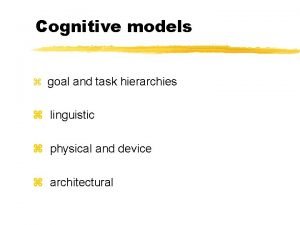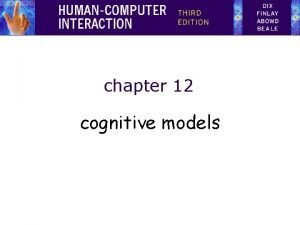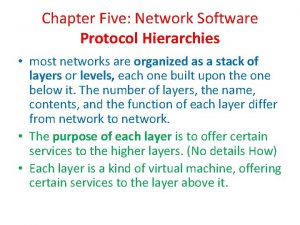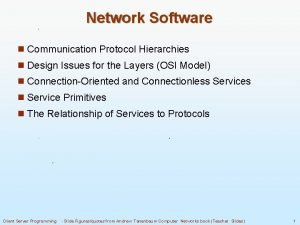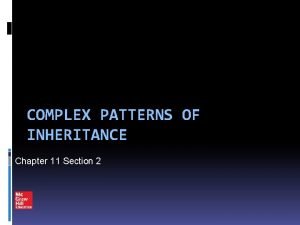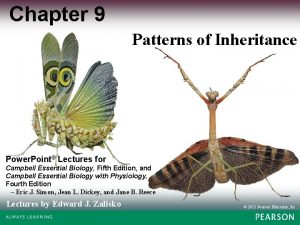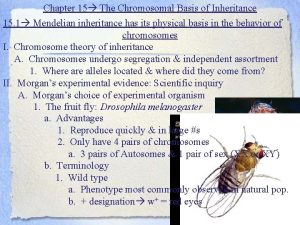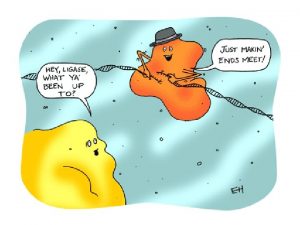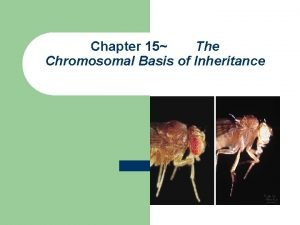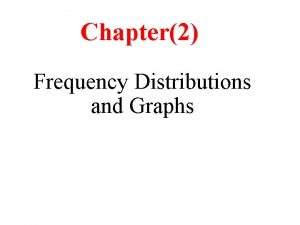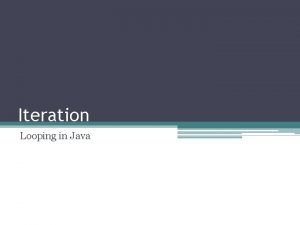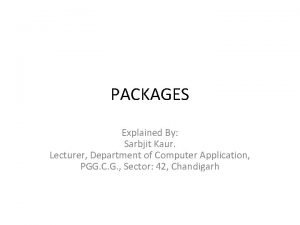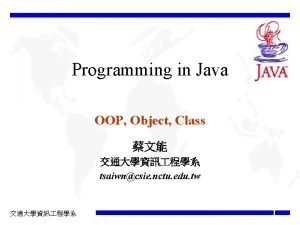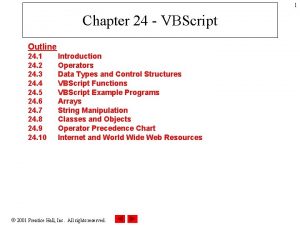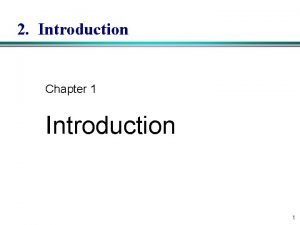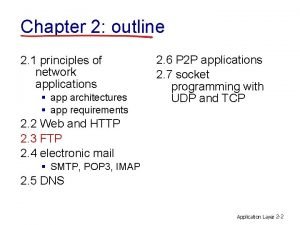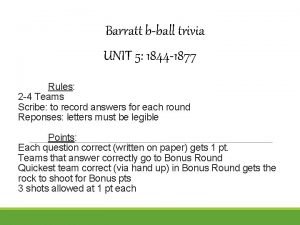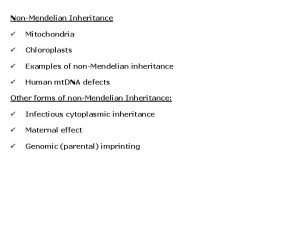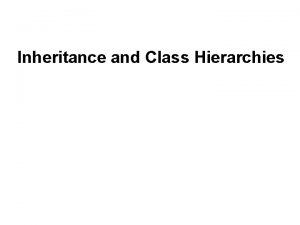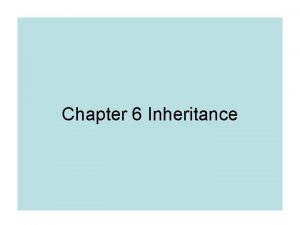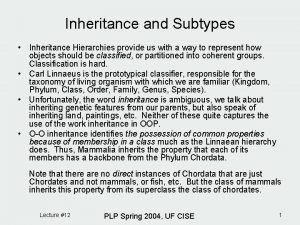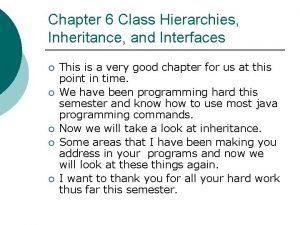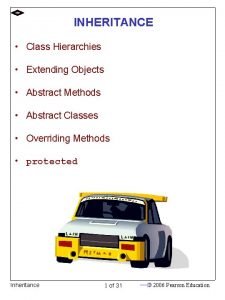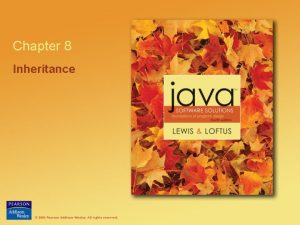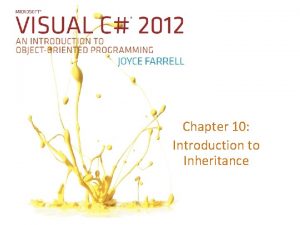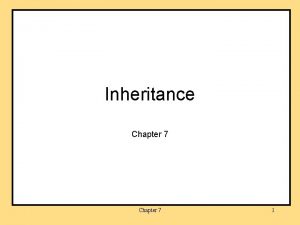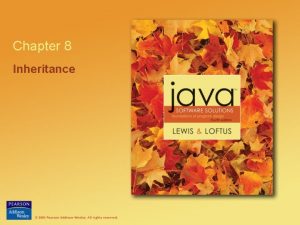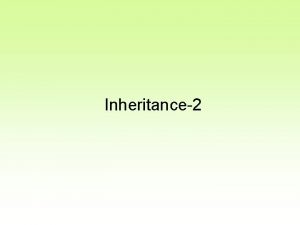Inheritance and Class Hierarchies Chapter Outline Inheritance and





























![Polymorphism Reduces Need For Type Tests // Non OO style: if (stuff[i] instanceof Integer) Polymorphism Reduces Need For Type Tests // Non OO style: if (stuff[i] instanceof Integer)](https://slidetodoc.com/presentation_image_h2/8bc7423490675ce3d544782100df12bb/image-30.jpg)










![The Object. clone Method (5) Employee[] company = new Employee[10]; . . . Employee[] The Object. clone Method (5) Employee[] company = new Employee[10]; . . . Employee[]](https://slidetodoc.com/presentation_image_h2/8bc7423490675ce3d544782100df12bb/image-41.jpg)
























- Slides: 65

Inheritance and Class Hierarchies

Chapter Outline • Inheritance and how it facilitates code reuse • How does Java find the “right” method to execute? • (When more than one has the same name. . . ) • Defining and using abstract classes • Class Object: its methods and how to override them • How to “clone” an object • The difference between: • A true clone (deep copy) and • A shallow copy Chapter 3: Inheritance and Class Hierarchies 2

Chapter Outline (2) • Why Java does not implement multiple inheritance • Get some of the advantages of multiple inheritance: • Interfaces • Delegation • Sample class hierarchy: drawable shapes • An object factory and how to use it • Creating packages • Code visibility Chapter 3: Inheritance and Class Hierarchies 3

Inheritance and Class Hierarchies • Object-oriented programming (OOP) is popular because: • It enables reuse of previous code saved as classes • All Java classes are arranged in a hierarchy • Object is the superclass of all Java classes • Inheritance and hierarchical organization capture idea: • One thing is a refinement or extension of another Chapter 3: Inheritance and Class Hierarchies 4

Inheritance and Class Hierarchies (2) superclass subclass Chapter 3: Inheritance and Class Hierarchies 5

Is-a Versus Has-a Relationships • Confusing has-a and is-a leads to misusing inheritance • Model a has-a relationship with an attribute (variable) public class C {. . . private B part; . . . } • Model an is-a relationship with inheritance • If every C is-a B then model C as a subclass of B • Show this: in C include extends B: public class C extends B {. . . } Chapter 3: Inheritance and Class Hierarchies 6

A Superclass and a Subclass • Consider two classes: Computer and Laptop • A laptop is a kind of computer: therefore a subclass methods of Computer and all subclasses additional Methods for class Laptop (and its subclasses) variables of Computer and all subclasses additional variables for class Laptop (and its subclasses) Chapter 3: Inheritance and Class Hierarchies 7

Illustrating Has-a with Computer public class Computer { private Memory mem; . . . } A Computer has only one Memory But neither is-a the other public class Memory { private int size; private int speed; private String kind; . . . } Chapter 3: Inheritance and Class Hierarchies 8

Initializing Data Fields in a Subclass • What about data fields of a superclass? • Initialize them by invoking a superclass constructor with the appropriate parameters • If the subclass constructor skips calling the superclass. . . • Java automatically calls the no-parameter one • Point: Insure superclass fields initialized before subclass starts to initialize its part of the object Chapter 3: Inheritance and Class Hierarchies 9

Example of Initializing Subclass Data public class Computer { private String manufacturer; . . . public Computer (String manufacturer, . . . ) { this. manufacturer = manufacturer; . . . } } public class Laptop extends Computer { private double weight; . . . public Laptop (String manufacturer, . . . , double weight, . . . ) { super(manufacturer, . . . ); this. weight = weight; } } Chapter 3: Inheritance and Class Hierarchies 10

Protected Visibility for Superclass Data • private data are not accessible to subclasses! • protected data fields accessible in subclasses (Technically, accessible in same package) • Subclasses often written by others, and • Subclasses should avoid relying on superclass details • So. . . in general, private is better Chapter 3: Inheritance and Class Hierarchies 11

Method Overriding • If subclass has a method of a superclass (same signature), that method overrides the superclass method: public class A {. . . public int M (float f, String s) { body. A } } public class B extends A {. . . public int M (float f, String s) { body. B } } • If we call M on an instance of B (or subclass of B), body. B runs • In B we can access body. A with: super. M(. . . ) • The subclass M must have same return type as superclass M Chapter 3: Inheritance and Class Hierarchies 12

Method Overloading • Method overloading: multiple methods. . . • With the same name • But different signatures • In the same class • Constructors are often overloaded • Example: • My. Class (int input. A, int input. B) • My. Class (float input. A, float input. B) Chapter 3: Inheritance and Class Hierarchies 13

Example of Overloaded Constructors public class Laptop extends Computer { private double weight; . . . public Laptop (String manufacturer, String processor, . . . , double weight, . . . ) { super(manufacturer, processor, . . . ); this. weight = weight; } public Laptop (String manufacturer, . . . , double weight, . . . ) { this(manufacturer, “Pentium”, . . . , weight, . . . ); } } Chapter 3: Inheritance and Class Hierarchies 14

Overloading Example From Java Library Array. List has two remove methods: remove (int position) • Removes object that is at a specified place in the list remove (Object obj) • Removes a specified object from the list It also has two add methods: add • (Element e) Adds new object to the end of the list (int index, Element e) Adds new object at a specified place in the list Chapter 3: Inheritance and Class Hierarchies 15

Polymorphism • Variable of superclass type can refer to object of subclass type • Polymorphism means “many forms” or “many shapes” • Polymorphism lets the JVM determine at run time which method to invoke • At compile time: • Java compiler cannot determine exact type of the object • But it is known at run time • Compiler knows enough for safety: the attributes of the type • Subclasses guaranteed to obey Chapter 3: Inheritance and Class Hierarchies 16

Interfaces vs Abstract Classes vs Concrete Classes • A Java interface can declare methods • But cannot implement them • Methods of an interface are called abstract methods • An abstract class can have: • Abstract methods (no body) • Concrete methods (with body) • Data fields • Unlike a concrete class, an abstract class. . . • Cannot be instantiated • Can declare abstract methods • Which must be implemented in all concrete subclasses Chapter 3: Inheritance and Class Hierarchies 17

Abstract Classes and Interfaces • Abstract classes and interfaces cannot be instantiated • An abstract class can have constructors! • Purpose: initialize data fields when a subclass object is created • Subclass uses super(…) to call the constructor • An abstract class may implement an interface • But need not define all methods of the interface • Implementation of them is left to subclasses Chapter 3: Inheritance and Class Hierarchies 18

Example of an Abstract Class public abstract class Food { public final String name; private double calories; public double get. Calories () { return calories; } protected Food (String name, double calories) { this. name = name; this. calories = calories; } public abstract double percent. Protein(); public abstract double percent. Fat(); public abstract double percent. Carbs(); } Chapter 3: Inheritance and Class Hierarchies 19

Example of a Concrete Subclass public class Meat extends Food { private final double prot. Cal; . . . ; public Meat (String name, double prot. Cal, double fat. Cal double carb. Cal) { super(name, prot. Cal+fat. Cal+carb. Cal); this. prot. Cal = prot. Cal; . . . ; } public double percent. Protein () { return 100. 0 * (prot. Cal / get. Calories()); }. . . ; } Chapter 3: Inheritance and Class Hierarchies 20

Example: Number and the Wrapper Classes Declares what the (concrete) subclasses have in common Chapter 3: Inheritance and Class Hierarchies 21

Inheriting from Interfaces vs Classes • A class can extend 0 or 1 superclass • Called single inheritance • An interface cannot extend a class at all • (Because it is not a class) • A class or interface can implement 0 or more interfaces • Called multiple inheritance Chapter 3: Inheritance and Class Hierarchies 22

Summary of Features of Actual Classes, Abstract Classes, and Interfaces Chapter 3: Inheritance and Class Hierarchies 23

Class Object • Object is the root of the class hierarchy • Every class has Object as a superclass • All classes inherit the methods of Object • But may override them Chapter 3: Inheritance and Class Hierarchies 24

The Method to. String • You should always override to. String method if you want to print object state • If you do not override it: • Object. to. String will return a String • Just not the String you want! Example: Array. Based. PD@ef 08879. . . The name of the class, @, instance’s hash code Chapter 3: Inheritance and Class Hierarchies 25

Operations Determined by Type of Reference Variable • Variable can refer to object whose type is a subclass of the variable’s declared type • Type of the variable determines what operations are legal • Java is strongly typed Object athing = new Integer(25); • Compiler always verifies that variable’s type includes the class of every expression assigned to the variable Chapter 3: Inheritance and Class Hierarchies 26

Casting in a Class Hierarchy • Casting obtains a reference of different, but matching, type • Casting does not change the object! • It creates an anonymous reference to the object Integer a. Num = (Integer)a. Thing; • Downcast: • Cast superclass type to subclass type • Checks at run time to make sure it’s ok • If not ok, throws Class. Cast. Exception Chapter 3: Inheritance and Class Hierarchies 27

Casting in a Class Hierarchy (2) • instanceof can guard against Class. Cast. Exception Object obj =. . . ; if (obj instanceof Integer) { Integer i = (Integer)obj; int val = i. int. Value(); . . . ; } else {. . . } Chapter 3: Inheritance and Class Hierarchies 28

Downcasting From an Interface Type Collection c = new Array. List(); . . . ((Array. List)c). get(3). . . Chapter 3: Inheritance and Class Hierarchies 29
![Polymorphism Reduces Need For Type Tests Non OO style if stuffi instanceof Integer Polymorphism Reduces Need For Type Tests // Non OO style: if (stuff[i] instanceof Integer)](https://slidetodoc.com/presentation_image_h2/8bc7423490675ce3d544782100df12bb/image-30.jpg)
Polymorphism Reduces Need For Type Tests // Non OO style: if (stuff[i] instanceof Integer) sum += ((Integer) stuff[i]). double. Value(); else if (stuff[i] instanceof Double) sum += ((Double) stuff[i]). double. Value(); . . . // OO style: sum += stuff[i]. double. Value(); Chapter 3: Inheritance and Class Hierarchies 30

Polymorphism and Type Tests (2) • Polymorphic code style is more extensible • Works automatically with new subclasses • Polymorphic code is more efficient • System does one indirect branch vs many tests • So. . . uses of instanceof are suspect Chapter 3: Inheritance and Class Hierarchies 31

Java 5. 0 Reduces Explicit Conversions • Java 1. 4 and earlier: Character ch = new Character(‘x’); char next. Ch = ch. char. Value(); • Java 5. 0: Character ch = ‘x’; char next. Ch = ch; // called auto-box // called auto-unbox • Java 5. 0 generics also reduce explicit casts Chapter 3: Inheritance and Class Hierarchies 32

The Method Object. equals • Object. equals method has parameter of type Object public boolean equals (Object other) {. . . } • Compares two objects to determine if they are equal • Must override equals in order to support comparison Chapter 3: Inheritance and Class Hierarchies 33

Cloning • Purpose analogous to cloning in biology: • Create an independent copy of an object • Initially, objects and clone store same information • You can change one object without affecting the other Chapter 3: Inheritance and Class Hierarchies 34

The Shallow Copy Problem (Before) Chapter 3: Inheritance and Class Hierarchies 35

The Shallow Copy Problem (After) Chapter 3: Inheritance and Class Hierarchies 36

The Object. clone Method • Object. clone addresses the shallow copy problem • The initial copy is a shallow copy, but. . . • For a deep copy: • Create cloned copies of all components by. . . • Invoking their respective clone methods Chapter 3: Inheritance and Class Hierarchies 37

The Object. clone Method (2) Chapter 3: Inheritance and Class Hierarchies 38

The Object. clone Method (3) public class Employee implements Cloneable {. . . public Object clone () { try { Employee cloned = (Employee)super. clone(); cloned. address = (Address)address. clone(); return cloned; } catch (Clone. Not. Supported. Exception e) { throw new Internal. Error(); } } } Chapter 3: Inheritance and Class Hierarchies 39

The Object. clone Method (4) public class Address implements Cloneable {. . . public Object clone () { try { Address cloned = (Address)super. clone(); return cloned; } catch (Clone. Not. Supported. Exception e) { throw new Internal. Error(); } } } Chapter 3: Inheritance and Class Hierarchies 40
![The Object clone Method 5 Employee company new Employee10 Employee The Object. clone Method (5) Employee[] company = new Employee[10]; . . . Employee[]](https://slidetodoc.com/presentation_image_h2/8bc7423490675ce3d544782100df12bb/image-41.jpg)
The Object. clone Method (5) Employee[] company = new Employee[10]; . . . Employee[] new. Company = (Employee[])company. clone(); // need loop below for deep copy for (int i = 0; i < new. Company. length; i++) { new. Company[i] = (Employee)new. Company[i]. clone(); } Chapter 3: Inheritance and Class Hierarchies 41

Multiple Inheritance, Multiple Interfaces, and Delegation • Multiple inheritance: the ability to extend more than one class • Multiple inheritance. . . • Is difficult to implement efficiently • Can lead to ambiguity: if two parents implement the same method, which to use? • Therefore, Java does not allow a class to extend more than one class Chapter 3: Inheritance and Class Hierarchies 42

Multiple Interfaces can Emulate Multiple Inheritance • A class can implement two or more interfaces • Multiple interfaces emulate multiple inheritance Desired, but illegal, situation Chapter 3: Inheritance and Class Hierarchies 43

Multiple Interfaces can Emulate Multiple Inheritance • Approximating the desire with interfaces: Chapter 3: Inheritance and Class Hierarchies 44

Supporting Reuse Using Delegation • Reduce “cut and paste polymorphism”: copied code • Idea: Object of another class does the work • Delegation: original object delegates to the other Chapter 3: Inheritance and Class Hierarchies 45

Delegation: Implementing It • Class Student. Worker implements interfaces Student. Int and Employee. Int • Class Student. Worker has-a Student and has-an Employee • Student. Worker implements (some) Student. Int methods with calls to its Student object • Likewise for Employee. Int methods • Student. Worker implements get. Name() itself, etc. Chapter 3: Inheritance and Class Hierarchies 46

Delegation: More About It • Delegation is like applying hierarchy ideas to instances rather than classes • There have been whole OO languages based more on delegation than on classes • Opinion: Classes are better, when they can do what you need • Downside of delegation: Not as efficient, because of level of indirection, and need for separate objects Chapter 3: Inheritance and Class Hierarchies 47

Packages and Directories • • A Java package is a group of cooperating classes Java programs are organized into packages The Java API is also organized as packages Indicate the package of a class at the top of the file: package the. Package. For. This. Class; • Classes of the same package should be in the same directory (folder) • Classes in the same folder must be in the same package Chapter 3: Inheritance and Class Hierarchies 48

Packages and Visibility • Classes not part of a package can access only public members of classes in the package • The default visibility is package visbility • Has no keyword: indicate by not using another • Others are: public, protected, private • Package visibility: between private and protected • Items with package visibility: visible in package, invisible outside package • Items with protected visibility: visible in package and in subclasses outside the package Chapter 3: Inheritance and Class Hierarchies 49

The No-Package-Declared Environment • There is a default package • It contains files that have no package declared • Default package ok for small projects • Packages good for larger groups of classes Chapter 3: Inheritance and Class Hierarchies 50

Visibility Supports Encapsulation • Visibility rules enforce encapsulation in Java • private: Good for members that should be invisible even in subclasses • package: Good to shield classes and members from classes outside the package • protected: Good for visibility to extenders of classes in the package • public: Good for visibility to all Chapter 3: Inheritance and Class Hierarchies 51

Visibility Supports Encapsulation (2) • Encapsulation provides insulation against change • Greater visibility means less encapsulation • So: use minimum visibility possible for getting the job done! Chapter 3: Inheritance and Class Hierarchies 52

Visibility Supports Encapsulation (3) Chapter 3: Inheritance and Class Hierarchies 53

A Shape Class Hierarchy Chapter 3: Inheritance and Class Hierarchies 54

A Shape Class Hierarchy (2) Chapter 3: Inheritance and Class Hierarchies 55

A Shape Class Hierarchy (3) Abstract classes Chapter 3: Inheritance and Class Hierarchies 56

A Shape Class Hierarchy (4) Chapter 3: Inheritance and Class Hierarchies 57

A Shape Class Hierarchy (5) Drawable. Rectangle delegates shape methods, such as Compute. Area, to Rectangle Chapter 3: Inheritance and Class Hierarchies 58

A Shape Class Hierarchy (6) Chapter 3: Inheritance and Class Hierarchies 59

A Shape Class Hierarchy (7) Chapter 3: Inheritance and Class Hierarchies 60

A Shape Class Hierarchy (8) Chapter 3: Inheritance and Class Hierarchies 61

A Shape Class Hierarchy (9) Chapter 3: Inheritance and Class Hierarchies 62

Object Factories • Object factory: method that creates instances of other classes • Object factories are useful when: • The necessary parameters are not known or must be derived via computation • The appropriate implementation should be selected at run time as the result of some computation Chapter 3: Inheritance and Class Hierarchies 63

Example Object Factory public static Shape. Int get. Shape () { String fig. Type = JOption. Pane. . (); if (fig. Type. equals. Ignore. Case(“c”)) { return new Circle(); } else if (fig. Type. equals. Ignore. Case(“r”)) { return new Rectangle(); } else if (fig. Type. equals. Ignore. Case(“t”)) { return new Rt. Triangle(); } else { return null; } } Chapter 3: Inheritance and Class Hierarchies 64

Next Lecture: On to Lists! Chapter 3: Inheritance and Class Hierarchies 65
 Issues for goal hierarchies
Issues for goal hierarchies Issues for goal hierarchies
Issues for goal hierarchies Rich feature hierarchies
Rich feature hierarchies A source monitoring error
A source monitoring error Network software protocol hierarchies
Network software protocol hierarchies Misguided little unforgivable hierarchies
Misguided little unforgivable hierarchies Protocol hierarchies
Protocol hierarchies Sandwich sentence writing
Sandwich sentence writing Chapter 11 complex inheritance and human heredity test
Chapter 11 complex inheritance and human heredity test Section 2 complex patterns of inheritance
Section 2 complex patterns of inheritance Chapter 16 the molecular basis of inheritance
Chapter 16 the molecular basis of inheritance Chapter 15 the chromosomal basis of inheritance
Chapter 15 the chromosomal basis of inheritance Chapter 9 patterns of inheritance
Chapter 9 patterns of inheritance Chapter 16 the molecular basis of inheritance
Chapter 16 the molecular basis of inheritance Chapter 15 the chromosomal basis of inheritance
Chapter 15 the chromosomal basis of inheritance The chromosomal basis of inheritance chapter 15
The chromosomal basis of inheritance chapter 15 Ap biology chapter 15
Ap biology chapter 15 Chapter 11 section 1 basic patterns of human inheritance
Chapter 11 section 1 basic patterns of human inheritance Chapter 11 section 1 basic patterns of human inheritance
Chapter 11 section 1 basic patterns of human inheritance Chapter 13-the molecular basis of inheritance
Chapter 13-the molecular basis of inheritance Chapter 9 patterns of inheritance
Chapter 9 patterns of inheritance Chapter 15: the chromosomal basis of inheritance
Chapter 15: the chromosomal basis of inheritance Introduction to ooad
Introduction to ooad Abstract concrete class relationship
Abstract concrete class relationship 7 rights of medication administration in order
7 rights of medication administration in order Static and dynamic class loading in java
Static and dynamic class loading in java Today's class work
Today's class work Putting a package together
Putting a package together How to calculate mode for grouped data
How to calculate mode for grouped data Class i vs class ii mhc
Class i vs class ii mhc Width of class interval
Width of class interval Stimuli vs stimulus
Stimuli vs stimulus Stimuli vs stimulus
Stimuli vs stimulus Class maths student student1 class student string name
Class maths student student1 class student string name What is the class width for the given class (28-33)?
What is the class width for the given class (28-33)? In greenfoot, you can cast an actor class to a world class?
In greenfoot, you can cast an actor class to a world class? Esd class levels
Esd class levels Analysis model uml
Analysis model uml Class 2 class 3
Class 2 class 3 Extends testcase
Extends testcase Package mypackage class first class body
Package mypackage class first class body Class third class
Class third class What is class attribute in java
What is class attribute in java Component class has composite class as collaborator
Component class has composite class as collaborator Labeling theory real life examples
Labeling theory real life examples Romans outline by chapter
Romans outline by chapter Work plan for research proposal
Work plan for research proposal Give me liberty ch 27
Give me liberty ch 27 Secondary data
Secondary data Chapter 38 a world without borders outline
Chapter 38 a world without borders outline 24 chapter outline
24 chapter outline What happens in chapter 8 of the hunger games
What happens in chapter 8 of the hunger games Chapter 31 societies at crossroads outline
Chapter 31 societies at crossroads outline Ap world history chapter 28 outline
Ap world history chapter 28 outline Advantages and disadvantages of sociology
Advantages and disadvantages of sociology Chapter 1 outline
Chapter 1 outline Chapter 1 outline
Chapter 1 outline Chapter 30
Chapter 30 Chapter 2 outline
Chapter 2 outline Outline of the book of acts by chapter
Outline of the book of acts by chapter Government spending multiplier
Government spending multiplier 24 chapter outline
24 chapter outline Forty niners apush
Forty niners apush Maternal effect and maternal inheritance
Maternal effect and maternal inheritance Advantages and disadvantages of inheritance in java
Advantages and disadvantages of inheritance in java Maternal effect and maternal inheritance
Maternal effect and maternal inheritance
